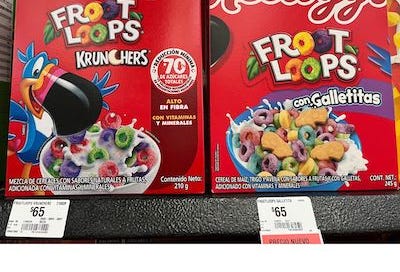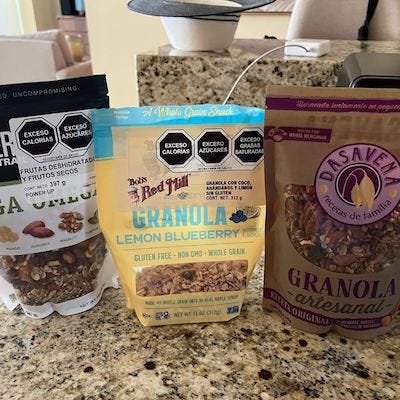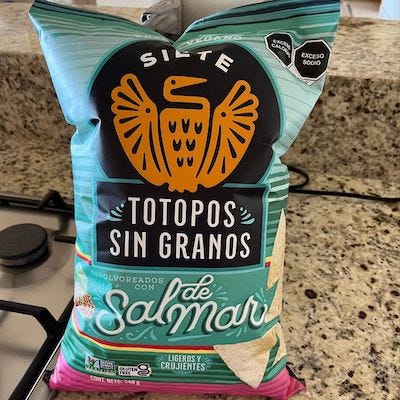America IS NOT On The Right Side Of Healthy Food
A trip to a Mexican supermarket confirmed what I already knew
Welcome to Roots! A newsletter about plant-based: eating, nutrition, lifestyle, I cover it all. Join me, Lori Osterberg, as I explore good food, great health, and Gorgeous Wellth! New here? Get started.
Thirteen years ago, I went to Europe for the first time. Our daughter was about to start her senior year of high school, so we took her for an extended vacation, hoping it would “change” her outlook on life. (Note: It did. 😀)
What we didn’t know at the time was how much it would change us too.
Because we spent several weeks at Airbnbs, we made many meals at “home.” Navigating the grocery stores is still one of the highlights of the trip - you learn so much about culture by shopping with the locals.
While the shopping experience intrigued us, something surprised us even more: the quality and taste of the food. Veggies had flavor. Packaged foods had basic ingredients - flour, sugar, cocoa - things you could actually read and pronounce.
It made it that much more surreal when we got home and compared it to the food we ate in the US. Even as a plant-based eater eating plants, it’s hard to find fruits and veggies bursting with flavor in the largest grocery stores. (You can find it when shopping local organic farmer’s markets where small farmers take pride in their products. And yes, even this is harder to find these days.)
This was our European experience over a decade ago. Things haven’t gotten any better. In fact, the US has a horrible approach to food production, and it’s showing up in our health.
A few months ago, I closely followed the Froot Loops #CancelKelloggs story.
Why do we allow big corps to feed us chemicals and poorly crafted food when what it’s doing to us is becoming more and more obvious? I realize this question opens up a massive can of worms, which we could debate for years without a conclusion. (That’s why we’re in this mess in the first place.)
But I did have a goal when I traveled to Mexico recently. I’d heard rumors Mexico makes two versions of Froot Loops - American and Mexican. The American version comes without warnings. The Mexican version isn’t allowed to target children; therefore, no toucan on the front, and warnings on the front label.
It’s true.
Here at one of our local stores, we found both versions sitting side by side. We are in a heavy expat area, so they sell both to satisfy clientele. Buyer beware, of course.
It didn’t stop with Froot Loops. Other brands are similar. The boxes and bags are clearly marked with warnings for excess sugar, excess calories, and excess saturated fats.
It makes you think twice when you walk down an aisle with warnings on the products that sit on the shelves back home.
It isn’t just cereal.
As we walked up and down the aisles of our local supermarket here in Mexico, we noticed the warnings everywhere. Cans of beans. Jars of salsa. Just about everything “American” had at least one warning.
Not good when food-related illness tops the list of chronic conditions.
I’m not saying the US is alone in this problem. This is a worldwide issue, and yes, Mexico also has its share of food-related problems.
It’s a growing concern.
Given that food is at the root of every health, mental, and societal problem we have in this world, any step forward could have a massive impact. It’s a $4.5 trillion problem that’s not going away without A LOT of change in the very near future.
This is a topic that goes on forever. There are so many approaches - What do you need to know right now?
For me, the best thing we can do as consumers is get better at reading nutrition labels.
Reading food labels is now no longer optional. It’s something you have to do every time you shop, especially when you’re picking up new items.
Tips For Reading Food Labels … The Right Way
Let’s start with one of the biggest misleaders … the front of the package. Everything on the front is designed to get you to buy the product. It’s marketing at its finest, not reality on how good the product is for you. (You only have to look back at the Froot Loops label to know that’s true. It is NOT part of a healthy breakfast.)
When at the store, ignore the front and turn the box or package around. It’s time to get close and personal with the ingredient list. Manufacturers list ingredients in the order of quantity, so the first ingredient is the most significant ingredient in the product.
The first three ingredients will have the biggest impact on the quality of the food. It is the majority of what you’ll be consuming. If those include things like refined grains, sugars, or oils, you can assume it’s unhealthy. Also, the longer the ingredient list, the more processed it is - buyer beware.
Now let’s talk about serving size. This IS NOT suggesting how much you should eat. It’s used as a manufacturer’s ploy to keep their numbers low. How often have you indulged on a half a can of soda? Or a single cookie? Yet the label may tell you that’s how big a serving size is to keep calories low. Look at what it says, then compare it to what you’ll be eating or serving. Do you need to adjust your thinking?
Sugar. We all know sugar isn’t good for health. Maybe you’ve even tried to avoid it. That’s difficult at best, considering how many different ways sugar is listed on nutrition labels. Take a look at how sugar may be listed in the products you shop for:
Basic simple sugars include:
Dextrose
Fructose
Galactose
Glucose
Lactose
Maltose
Sucrose
Solid or granulated sugars include:
Beet sugar
Brown sugar
Cane sugar
Cane juice crystals
Castor sugar
Coconut sugar
Confectioner’s sugar
Cory syrup
Crystalline fructose
Date sugar
Demerara sugar
Dextrin
Diastatic malt
Ethyl maltol
Florida crystals
Golden sugar
Glucose syrup solids
Grape sugar
Icing sugar
Maltodextrin
Muscovado sugar
Panela sugar
Raw sugar
Sugar
Sucanat
Turbinado sugar
Yello sugar
Liquid or syrup sugars include:
Agave syrup
Barley malt
Blackstrap molasses
Brown rice syrup
Buttered sugar
Caramel
Carob syrup
Corn syrup
Evaporated cane juice
Fruit juice
Fruit juice concentrate
Golden syrup
High fructose corn syrup
Honey
Invert sugar
Malt syrup
Maple syrup
Molasses
Rice syrup
Refiner’s syrup
Sorghum syrup
Treacle
And this doesn’t include artificial sweeteners or sugar substitutes! Crazy, right?
I also want to mention those pesky words “natural flavors” and “natural colors.” They sound downright good for you, don’t they? Nope, don’t believe it. I once saw them described as enhancers for a product’s flavor and sensory experience. They are extracted from plants and animals in order to accomplish that. I like to think of these as “proprietary” ingredients for the manufacturer to add whatever secret ingredient they choose. FoodBabe had this to say about natural flavors:
“Flavor companies own these proprietary formulas… making it near impossible to find out exactly what’s in them. You’d like to think that “natural apple flavor” is just some juice extracted from an apple and inserted into the food. Nope. That “natural apple flavor” needs to preserved and stabilized and has agents added to help it mix well into a product. This is why flavors can contain upwards of 100 ingredients like propylene glycol, polysorbate 80, BHT, BHA… all considered “incidental additives” not required to be labeled by the FDA. The FDA doesn’t require companies to tell you what is in the flavors they use. It’s a complete mystery ingredient.”
I once had a client say, “Why does this all have to be so hard? I don’t know what I don’t know, and I don’t even know where to look.”
Honestly, you almost need a PhD to keep up with it all. And that’s exasperating at best.
Why do all that? Why pay attention? Why care?
I believe you’ll pay for it one way or another - either in the price of the food, or in the consequences to your health.
I’ve learned a lot in the three decades since my dad died of a massive heart attack at the age of 54.
I’m all for healthy food. I make my choices, and pay attention. Unfortunately, that’s the best road to take in this journey for now.
p.s. Did you like this message? It would mean a lot to me if you’d press the ❤️ below if you liked it, left a comment 💬, or shared it with a friend. I’m trying to grow this publication, and I depend on people like you to do so!
And if you’re new here, Welcome! 💐 I’d love to start sharing my message with you if you’re interested in all things plant-powered, proaging, or finding kitchen joy. Subscribe … and then explore my entire archive! Glad to share with you! 🙋🏼♀️












